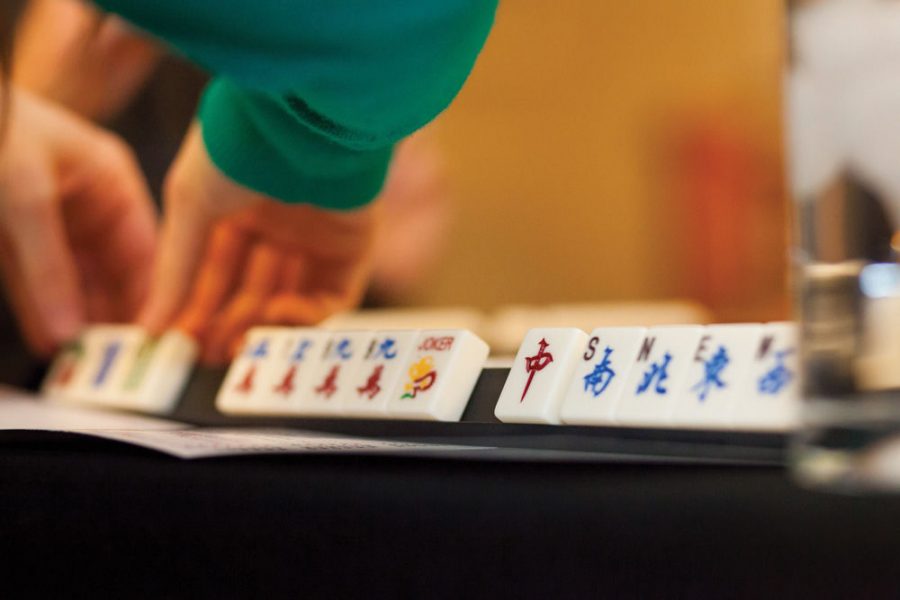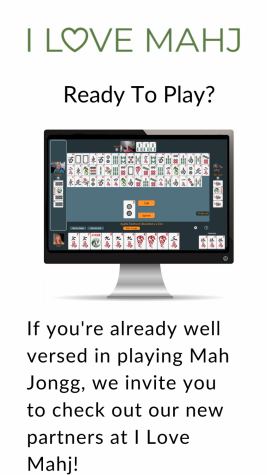This Week in Mah Jongg: Game Strategy (Part 2)
Published September 28, 2021
In our previous article, we discussed strategies related to the very beginning of the game of American Mah Jongg. We homed in on tile organization and how to determine which hand(s) or section(s) of the card to focus on. In this article, we’ll be moving on to Charleston-related strategies.
The Charleston is a hugely important segment of the game, as players receive up to 21 new tiles during this process. These tiles offer a fantastic opportunity to significantly shape or strengthen a potential hand at this early stage of the game.
CHARLESTON STRATEGY
The Charleston is your chance to:
- Narrow down potential hand options, if you’re targeting a particular section
- Reinforce your hand, if you’ve zoned in on a specific one
- Choose between potential options, if you were spread over several sections of the card
- Collect supporting tiles for backup hands
- Hold back from passing potentially valuable tiles (eg, flowers, pairs) so as not to strengthen another player’s hand.
General process
Though you are narrowing down your options, you don't necessarily need to come out of the Charleston with a specific hand to play. Through each step of the Charleston, you will be gaining a more precise idea of the direction you will be heading, and eliminating potential options that failed to strengthen. Though it's good to keep options open, there’s no need to retain too many options, as this could lead to confusion.
Using the strategy ideas described in our previous article, you’ll pass the three tiles that fit the least, based on your current assessment. Then, given the three tiles you receive, you go through that same process again. Rinse and Repeat.
Remember, that as long as you have three tiles to pass, there is no need to lock yourself into a particular hand just yet. However, once you find yourself in the position of having two or fewer tiles (and you can't blind pass), you will be forced to make a decision, and pick one potential hand over another (or one section over another)
Passing strategy
Besides discarding tiles that do not help your hand, you also need to be careful what you are passing to others. Your discards could potentially help an opponent to get ahead, so it would be wise to avoid passing tiles that could be valuable, such as:
- Pairs - If you need to discard a pair, break that pair up and pass to two different players, or keep the pair for later use as joker bait (please see the Q & A section below for more information on joker bait)
- Flowers - These are generally in high demand, so avoid passing them if possible
- White dragons - Due to their versatility as dragons and zeros, it’s best to be cautious and only pass as a last resort. If you do pass a white dragon, be especially aware of the tiles you are passing along with it. For example, in 2021, you would want to avoid passing 2’s or 1’s with a white dragon, as these three tiles are prevalent in the 2021 section of the card.
Also, it's best not to pass groups of tiles that naturally fit together in a section. In particular, avoid passing:
- Tiles with the same number (even if different suits)
- Tiles whose numbers are consecutive or close numerically
- All even-numbered tiles
- All odd-numbered tiles
- Tiles that all fall in the 369 category
- Tiles of all the same suit
- All wind tiles.
In other words, mix things up so as not to give your opponents an advantage.
Paying attention to what gets passed
Though your main focus in the Charleston is to strengthen your hand, it is also important to pay close attention to the tiles being passed by others. Remember, the defensive part of Mah Jongg is an important aspect when it comes to excelling at the game. This involves being able to identify which hands your opponents may or may not be playing.
To that effect:
- Discreetly observe which tiles are kept by the player receiving your passed tiles (maybe they slot them between tiles in their rack, rather than putting them to one end)
- Do your best to remember which tiles you passed that you do not see again during the Charleston, as it’s highly likely someone is collecting these!
- Keep track of the types of tiles that you didn't receive. For instance, if you're getting no winds during the Charleston, it's likely someone is collecting winds. You may be able to narrow down who it is through successive passes.
When to stop the Charleston
After the first Charleston, players have the option to complete another three passes during a second Charleston. Alternatively, players can decide to skip the second Charleston and move on to the Courtesy pass.
Some players systematically move into the second Charleston, while others always want to stop after the first Charleston. In the case of the latter, many players find themself feeling short-changed and often a little angry at the player who wishes to stop, especially if this is a regular occurrence. Please note, each player has the right to stop the passing after the first Charleston, as stated in the NMJL’s rules.
However, whether or not to move on to the second Charleston should be a conscious decision, based on the tiles in your hand. The main reason to stop the Charleston would be that you have a strong hand and do not have three tiles to pass. Therefore, if you have at least three tiles that can be discarded, it's best to continue the Charleston. Worst case, you get nothing useful in the remaining passes but you're no worse off. Plus, the second Charleston generally takes far less time than the first, mainly due to players being more focused on particular hands during this round.
If, during the first pass of the second charleston, you see many tiles that were circulating during the first Charleston, this gives you an indication of what others likely aren’t collecting. Additionally, this knowledge may be a sign that you should adjust your hand, should it have failed to strengthen during the first Charleston. For example, if lots of winds were circulating in the first Charleston and are also circulating in the second Charleston, this might be a great opportunity to start collecting these and switch to a hand that uses wind tiles.
The only awkward scenario can occur on the second "across". If you only had three discards when starting the second Charleston and you received a useful tile during the “second left” pass, you now find yourself having to pass a valuable tile. In this case, discard a tile that will be the easiest to replace. For instance, if the tile you just received completes a pair, then pass another tile (which may have previously been part of a pung or kong). This is because you have a good chance of being able to replace it from the discards or with a joker later. It’s certainly preferable to pass a tile from a completed set, which would enable you to claim it back as soon as it is discarded by another player. So, even in this case, you're better off opting to go ahead with the second Charleston.
The Courtesy Pass
The very last part of the Charleston is the optional Courtesy Pass, which takes place between players seated directly opposite one another. Zero to three tiles may be passed between these players.
If the player opposite you stopped the Charleston, then it would probably be a prudent move to skip passing them any tiles during the Courtesy (especially if they only offer one tile). The reasoning for this is that they could very well be quite close to Mah Jongg and you do not want to hand them their Mah Jongg tile at this early stage!
The issue with this defensive move is that you don’t get the opportunity to receive any potentially interesting tiles either. You will need to decide, depending on the strength of your hand, whether the risk is worth taking. If you have a strong hand and a good chance of winning the game, then the risk of passing tiles in this scenario may be worth it.
Ultimately, you don’t know for sure that your opponent stopped the Charleston because they were only a few tiles away from Mah Jongg. It may well be that they have a split hand and they just can’t decide which way to go!
A similar issue arises when your opponent didn’t stop the passing, but only wishes to pass one tile during the Courtesy and you’d like to pass three. Now what? Well, you either have the opportunity to pass one tile or to refrain from passing. In this case, it’d be prudent to skip the Courtesy altogether.
As we mentioned early on in our strategy articles, there is no right or wrong answer when it comes to strategy, it’s a balancing act between many factors!
Well, that completes our strategy discussion for the initial stage of the game. Next time, we’ll move into the game proper and will cover early game strategies. In subsequent articles, we’ll cover mid- and end-game strategies, since strategy will vary depending on how far along in the game you are.
Practicing your defensive play skills
Although each game we play is a learning experience in itself, the fast pace means it’s not always conducive to analyzing our thought processes and furthering our skills. This is where I Love Mahj’s Practice Mode comes into its own. This has proven to be an extremely popular tool on the I Love Mahj platform! By choosing to play in this mode, you’d receive hand suggestions from the very beginning of the game to the end. This enables you to check your choices and confirm that you are playing the most effective hand for your given set of tiles, at any point in the game.
Additionally, once a bot has exposed tiles, you’ll be able to reveal a list of all the potential hands that bot may be aiming for. This enables you to ramp up your defensive play skills! The information will help guide you with regards to discards and timing, so as not to give your opponent an advantage, if at all possible.
Last but not least, when playing in Practice Mode, the discards are grouped and displayed with a counter (instead of being displayed chronologically). The counter background will change color, based on the number of discards for each particular tile (green: no tiles out / orange: some tiles out / red: all tiles out). Players also have the option to include exposed tiles in the count, so that they can clearly see how many of each tile is still in play. And just for good measure, clicking on any particular tile in the counter will display who discarded that tile and how many, and also the number exposed (if the “exposures” box is checked). This is a great way to challenge your memory regarding discards! If you’re interested in trying the online game, just head over to ilovemahj.com and sign up for the free trial.
Final Thoughts
For those of you who are less experienced at Mah Jongg, please remember that deciding on a hand is one of the most difficult choices you’ll make in a game. It’s something that comes with experience and familiarity with the card, so definitely don’t be too hard on yourself if you are struggling with this aspect of the game. And, if you’re a complete beginner, it’s good to be aware of strategy, though don’t worry if you’re just too busy trying to get the hang of the rules and deciding on which hands to play to actually focus on anything else!. It’s totally OK, we get it. Just know that eventually, you’ll be able to take your game to the next level by working on your game strategy.
Q&A’s
Readers’ questions:
Q: If I’m playing a hand with an X next to the values on the NMJL card, do I have to expose tiles at some point during the game?
A: Not at all. You can certainly play an exposed hand without making any exposures if you do not need to claim any discards to complete the hand.
Q: I’ve decided to play a hand from the Singles and Pairs section but was dealt a joker. Can I pass a joker in the Charleston?
A: No, a joker can never be passed in the Charleston. However, it’s useful to hang on to the joker for as long as possible in case your chosen hand doesn’t work out and you need to switch to a backup. If your hand is progressing well, you can discard your joker later in the game.
Q: If I have a tile that could be exchanged for a joker, but I don’t need that joker, what should I do?
A: You should (probably) discard that tile - additional info below. If you choose to discard, wait as long as possible before doing so, as this action will give your competitors information about your hand. Also, if you’re playing for money, or in a tournament, it’s actually advantageous to discard that tile, as the joker exchange could make your opponent’s hand jokerless (which would increase its value). However, there are other considerations here, such as how far through the game you are and could someone else claim that joker? Let’s say it’s a flower and only 4 are visible in the discards and exposures. In this case you may choose to exchange that tile for the joker to prevent someone else from getting it. You can then discard the joker later in the game.
Q: I’ve heard the expression “joker bait”. What does this mean?
A: Joker bait refers to keeping hold of a pair, even though you can’t use these tiles in your hand. When discarding one of these, your hope is that someone will call that tile and use a joker in their exposure. On your next turn, you’d then be able to claim the joker. Timing is important here, as discarding too soon may mean that the tile can’t be picked up as players haven’t accumulated enough jokers to do so, and too late could mean giving your opponent Mah Jongg. Generally, discarding around the middle of the game (3rd wall) is considered a good bet. Obviously, this is a speculative move, but occasionally it pays off and when it does, it’s awesome!
See you next time! In the meantime, keep your questions coming! Please email them to [email protected].















